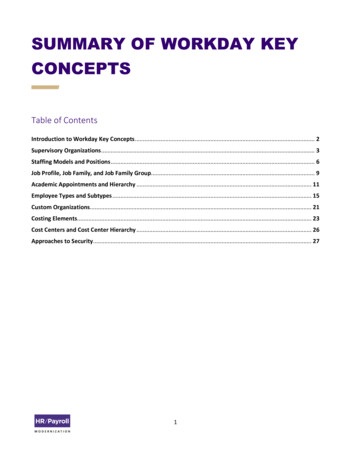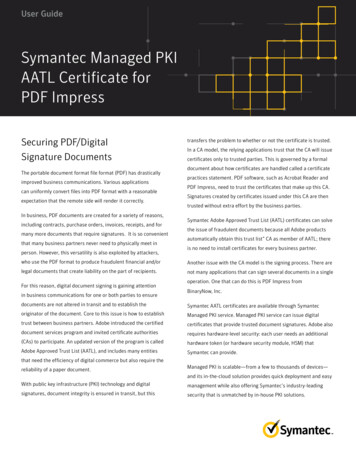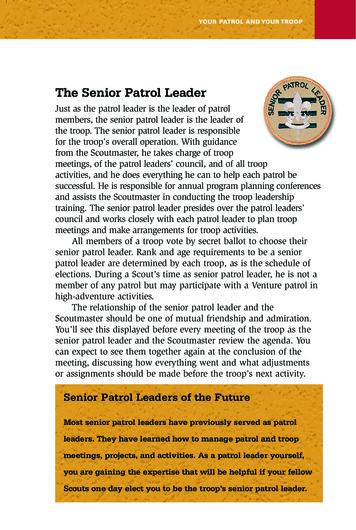
Transcription
THELEADER’SGUIDETO SUCCESSFULTEAM BUILDING
04Aesop’s Fable:A Tale of Teamwork06CONTENTSClickANYar tictitleleto try ourNEWinteeBook ractivemenu!4 Reasons to Focus Your Team Building AroundTeam Players, Not Just High Achievers08How Team Assessments TurnIndividuals into “Invaluables”108 Daily Tips to Build aWinning & Motivated Team12What NOT to DoWhen Team Building167 Ways to Boost Moralein the Workplace18The Secret to SuccessfulTeam Building2
INTRODUCTIONFrom an early age, we understandthe importance of teamwork and teambuilding. It’s vital to our playgroundsurvival and, as we get older, it’s just asimportant to our business success.Despite our instinctive nature, it’s notalways easy to build a winning team.Creating a team building culture startswith an organization’s mission, values,and organizational culture. Teambuilding takes many forms. It’s anongoing process that encourages awork group to evolve and perform as acohesive unit. Team members not onlyshare tasks, but an end goal, andideally work together with trust,support, and respect.Team building is imperative in creatingand maintaining engaged employeeswho are happier at work, moreproductive, and routinely go above andbeyond their job descriptions. Theyalso encourage other employees to bemore engaged and productive. Mostimportantly, these workers are proudto be a part of their companies, andare more likely to stay long-term.There is no clear-cut set of actions forteam building to create increasedengagement levels; you will needto identify opportunities, simplifysolutions, take action, and hold peopleaccountable for following through withthe policies and plans you put in place.Team building is so much more thanactivities and monotonous “icebreaker” or “familiarizing” exercises. Ifyou want to create an atmosphere thatfosters collaborative team building andhigh engagement levels, this eBookwill illustrate the importance, hurdles,and ways to help your company achievesuccessful team building.To learn more about our solutions, call us at 866.751.1644
AESOP’SFABLE:HAVE YOU EVER HEARD OF AESOP’S FABLE,The Belly and the Members? If not, the fable reads:“One fine day it occurred to the Members of the Bodythat they were doing all the work and the Belly washaving all the food. So they held a meeting, and aftera long discussion, decided to strike work till the Bellyconsented to take its proper share of the work. So fora day or two, the Hands refused to take the food, theMouth refused to receive it, and the Teeth had no workto do. But after a day or two the Members began tofind that they themselves were not in a very activecondition: the Hands could hardly move and the Mouthwas all parched and dry, while the Legs were unable tosupport the rest. So thus they found that even the Bellyin its dull quiet way was doing necessary work for theBody, and that all must work together or the Body willgo to pieces.”When we underestimate the importance of each memberon a team, group dynamics has a tendency to fall apart.Getting a feel for how an individual responds to conflictcould prevent some major stress and tension within thegroup down the road. The easiest way to reveal this vitalinformation can be through the use of assessments.Similar to Aesop’s Fable, it is important to recognize anindividual’s distinct skills, behaviors, and strengths in orderto utilize the team dynamics and achieve an effectiveteam.4A Tale ofTeamwork
“So thus they found that even the Belly in its dull quietway was doing necessary work for the Body, and thatall must work together or the Body will go to pieces.”Team dynamics can be complex because each individualbrings a different skill to the table. One person may bemore productive, one may handle conflict better, one maytake initiative, or one may be better at problem solving.When the team understands what each person’s skills are,then they will be more supportive and tolerant towardsthat individual. Knowing each person’s strengths will bringthe team closer together.In team dynamics, each person may have diversebehaviors. From the time you are born you developbehaviors. It’s likely that no two team members had thesame upbringing or type of household, therefore they mayhave different values, beliefs, or social norms. Behaviorscould lead to group conflict as well. Again, knowingand understanding each team member’s behaviors willencourage the team to be more supportive of each other,which in turn opens up communication amongst theteam.Also, personality plays a key role in team dynamics. Noteveryone has the same type of personality. Yourpersonality is made up of your thoughts, feelings, andbehaviors, and that is why it is unique to you. Teammembers may misconstrue another member’s position ifthey cannot identify with that individual’s personality. Oneteam member may be shy, quiet, or calm, and anotherperson may see that team member as withdrawn or lazy.In reality, that is not the case. That is why it is importantfor everyone to recognize and adapt to each individual’spersonality.So how do you understand skills, behaviors, andpersonality traits? The best way is through assessments.Employee behavior is often compared to an iceberg—about 90 percent of our behaviors are explained by factorsthat, on the surface, cannot be easily observed orunderstood. Assessments go below the surface andprovide you with in-depth, reliable information. Theygive specific data on how to reduce conflict, opencommunication, and increase productivity with anindividual. They can also tell you an individual’s thinkingstyle, behavioral traits, and if they have the rightcharacteristics for a specific position. When building asuccessful and effective team, assessments are the placeto start.So what’s the moral of the story? Each person brings adifferent skill set, behavior, and personality to a team.Sometimes, it may seem that certain team members aredoing more work than others, but that is not always thecase. That’s why team communication is a key focus fororganizations worldwide!T5o learn more about our solutions, call us at 866.751.1644
4 REASONSTo Focus Your Team Building AroundTeam Players, Not Just High AchieversEVERY TEAM IS DIFFERENT, BUT ALL HAVE Acommon interest in the desired end goal. This is the reasonthe team exists. Pursuit of this end goal is the measure ofa team’s success. It does not matter if a team is comprisedof the best employees at your company; if they are notmaking timely progression toward a goal, the team islikely to fail. It may seem that selecting the highestperforming employees would make the most successfulteam possible, however, grouping them together may notyield desired results.High performers who lack teamwork skills are typicallyresults-driven and eager to show managers how theyalone have contributed to improving the bottom-line.Their emphasis on personal results can cause them to losefocus on what is in the team’s best interest. The foundationof a team should be high-performing employees whoare also team players. Team players are excited to identifythemselves as a part of the team, and this enthusiasm gets6other employees excited. Every manager building a teamshould create them based on team players. Here are fourreasons why:1. They are passionate.Team players give up personal benefits for the team’sgain. These employees are so enthusiastic about ateam’s goals that they are willing to take on any task,even if it is not one of their typical job duties. Highperformers who lack teamwork skills tend to prefer tostick with what they know, because it is the best wayfor them to shine.2. They are not on the team for personal gain.The days of loyalty to one or two companies duringan employee’s career are over. Employees today oftenaccept jobs that may not seem attractive to them atfirst to gain skills and then move on. Managers,however, still value loyalty and dedication to the
The foundation of a team should be high-performingemployees who are also team players.company. Successful team members typically believein the company and see themselves as a piece of apuzzle helping to move the company forward.3. Their personality fits well with other potentialmembers of the team.How well a team engages with each other can bethe difference between a soaring success and anembarrassing failure. No matter how great theteam looks on paper, poor attitudes and clashingpersonalities can halt productivity. Team playerstend to be cooperative and good listeners. Highperformers who have a difficult time cooperatingwith other people may not be the best fit for a team.Assessments can measure and describe the behavioralcharacteristics of individuals, helping team membersget to know each other far more thoroughly thanthrough experience and interaction alone. Talentassessments can provide insight into how anindividual may perform, but people often actdifferently as members of a group than they wouldact alone. A team analysis assessment providesinvaluable insight into how members may respondwhen they become members of a group, and how toguide that response to ensure optimum performanceof the team and its members.4. Team players are more likely to ask for inputfrom all team members.High achievers often have great ideas and are awareof their capabilities. This can make them likely todiscount other employees’ ideas if they are notaccustomed to being on a team. An effective teammember listens to everyone, because theyunderstand that collaboration brings to light newways of fixing problems.Asking employees directly why they want to be a part ofa team is a good idea. This all stems back to the companyculture. If leadership and management encourage thiskind of behavior and communication from the top down,employees from all departments are likely to adopt thesepractices. Don’t just focus on high-performers; buildyour team and engage all employees to create a solidfoundation of 100 percent team players. With a littlefocus, engaged team players can easily become your nextbest-performers. Encourage each and every employee tobe active and involved in company team building.T7o learn more about our solutions, call us at 866.751.1644
How Team Assessments TurnINDIVIDUALS Into “INVALUABLES”WHEN IT COMES TO SELECTING A HIGHperforming team, team assessments are essential,especially when conflicts arise. Here’s a common scenario:You’ve assembled an expert team of workers who fittheir jobs well and are aligned with organizationalgoals. They are high performers, and you could not bemore pleased with each of them individually.Yet, something is off. For example, Jake almostnever appears satisfied with answers to his questions,feedback from his team leader, or anything related towork. He’s impatient, irritable, and his dissatisfaction isrubbing off on other team members. Individually, he’sextremely skilled at his job and plays a vital role in theteam.Jake’s manager, Sarah, consistently ensures her teamis performing superbly by meeting deadlines andcommunicating well with internal and external clients,but there is friction between her and Jake within theteam.Let’s say you have a big plan for the team: a projectthat they will spend most of the year developing beforepresenting to external clients. You believe they havethe talent to get the job done, but you have an intuitivefeeling about their chronic inability to get along. You’veseen how the small annoyances between two peoplecan fester and grow, which in turn threatens the entireteam.So what do you do now? Before you involve Sarah’steam in the new project, step back and assess. Literally.Take a few minutes to examine the source of the friction8
and figure out how to dissolve it, before it dissolves thishigh-performing team.Profiles Performance Indicator and its Team AnalysisReport are the prescribed methods of finding theunderlying cause of conflict in your team and improvingteam communication. Its reports can help you form newteams, or help team leaders like Sarah understand theteam better so that they can dissolve any friction.Organizations utilize team assessments to motivate andcoach employees and resolve performance issues. Theycan measure a worker’s motivational intensity and actionsrelated to: ProductivityQuality of workInitiativeTeamworkProblem solvingAdapting to changeResponse to conflict, stress and frustrationAs mentioned in the articles in this eBook, assessmentscan measure and describe the behavioral characteristics ofteam members, helping them get to know each other farmore thoroughly than through experience and interactionalone. Assessment reports can explain how teammembers’ characteristics may complement each otherfor maximum team effectiveness, or counter one anotherleading to challenge areas for the team. Knowing howother team members are likely to perceive and approachcertain situations helps team building in a number ofdifferent ways. Team communication improves, groupeffectiveness is enhanced, and productivity soars.To learn more about our solutions, call us at 866.751.1644
WILL YOU MAKE A CONSCIOUS EFFORT IN YOURdaily routine to fire up your team like never before? Thesooner you can launch a new employee into productivity,the better off you, the employee, and your organizationwill be. We’ve outlined eight simple steps you can add toyour daily and weekly routine to help you boostengagement and morale.Employees want management they can look up to, notmanagement that looks down on them. An honestrespect for all and a genuine recognition confirmingthat everyone has something to offer is at the heart ofa successful motivator. Without respect, so-calledmotivation becomes manipulation, and manipulation isnever successful in the long term. Here are tips to get yourteam excited about work:1. Take an interest in the career and personalgoals, aspirations, interests, lives, and familiesof those who work for you.“Motivation” is about giving your people a “motive foraction.” Understand what your employees value, andyou can easily formulate a way for them to fulfill theirpersonal goals as well as your own. Take an honestinterest in every one of your people, and the means tomotivate them will become readily apparent. Make ita goal to learn something new about at least one ofyour people every day. Don’t get “too personal,” butmake a point to understand each individual’s personalgoals. For example, did you know your IT director hasa passion for blogging? Connect him or her with yourblog editor to see if they can contribute to thecorporate blog. Perhaps your sales intern is struggling108 DAILY TIPSTO BUILDA WINNING &MOTIVATED TEAM
with accounting in school. If appropriate, check if theycan have a working lunch with your head ofaccounting to ask some questions.2. The best way to knock a chip off a person’sshoulder is to let them take a bow.Do you know anyone who complains about gettingtoo much recognition or praise for a job well done?Unlikely! Yet, research consistently shows that peoplewill go to extraordinary lengths for a leader who takesthe time to catch them doing something right, andwhen they do, provides them with sincere praise andrecognition in front of their colleagues. Praise andrecognition are more motivating than money or anyother thing leaders can offer.3. Don’t criticize, condemn, or complain.Dale Carnegie nailed it with this gem: “When youmust draw attention to poor performance, don’tcriticize—coach!” Don’t criticize what is being donewrong, but focus all of your attention on the newbehavior or action that will put things right. Alwaysfinish with a positive comment to let them see thatthe reason you’ve raised the matter is that you haveseen they are capable of so much more. Correct theerrant action, provide some positive feedback, andthen forget it. Act like you expect better performancenext time, and you’ll get it.4. Request—don’t order.Real leaders lead from the front—they don’t need topush from the back. Everyone rebels to some extentagainst being “bossed around.” No one minds beingasked for help.5. Discuss—don’t argue.Maturity is about being able to disagree agreeably.6. Be careful with humor.Avoid any kind of demeaning humor. If there’s theslightest chance of being misunderstood, keep it toyourself. “If in doubt, leave it out!”7. Listening is the greatest compliment you canpay anyone.Our opinions are all sacred to us. Listen and hear theconcerns of your people.8. Most important of all Model the behaviors, attitudes, and morale level youexpect others to display. Show them it works.Take the topics discussed above and apply them everyday. You will discover that in a short amount of time,you will be doing all of these things naturally. And, thelevel of motivation in your team in general—even in your“toughest cases”—will achieve an all-time high.Team building is easy if you care enough to put in a littleextra effort. Anyone can motivate, and anyone can bemotivated. All it takes is the right person in the right place,managed by someone who cares. Invest a little time overthe next year, and fire your team up like never before!To11 learn more about our solutions, call us at 866.751.1644
NOTWHATTO DOWHEN TEAM BUILDINGTEAM BUILDING AND TEAM DEVELOPMENT AREimportant in order to have a highly-functional, productiveteam. However, all too often managers have the wrongidea about what team development is. There is adifference between team building and team fun. Sure, funcan cultivate bonding—and should be enjoyed—but it isnot the same as team development. In an NPR interview,Peter Brooks recounts one incident of how team fun wenthorribly awry, all in the name of team development:“We were issued safety goggles and paintball guns, oneof which immediately misfired. It hit a district managerin the crotch. A lot of people pointed their guns right attheir supervisors, me included. I shot mine right in themiddle of the back, and then when he spun around withrevenge in his eyes, I surrendered. I think we were all reallyunprepared at the impact, literally —emotionally andphysically— the impact of shooting paintballs at eachother,” Brooks said. “People were very mad at each other.There were apologies. There were heartfelt apologies.”While stories like these are amusing, it should be notedthat team building can be inappropriate and get out ofhand. The following list details five ways you canguarantee a bad team building experience, with real-lifeexamples from The Fast Track:12
People should be challenged in the workplace so theycan learn and develop themselves, but being forcedinto situations—especially physically dangerous ones—is not an effective approach to team development.1. Wrong activity at the wrong time.When you effectively plan a team building exercise toincorporate learned skills with appropriate workplaceskills, the effects will be lasting and every employeewill go home feeling fulfilled, most likely bringingwhat they learned in their team building experienceto work with them. That’s not always the case. Oneperson wrote about a team building retreat held afteran employee was let go due to a poor work ethic. “Itwas all fun and games until the consultant held anincreasingly uncomfortable debriefing session wherewe had to write down what we didn’t like about theassociate who was fired, then had to go around andshare aloud. Then the consultant passed around a boxfor the slips of paper and presented the box to theowner and very seriously said, ‘When you are all atthe office again, you need to have a purgingceremony and burn this box with all the baggageinside.’” That type of activity is irrelevant andunhelpful to all parties involved.2. No application to work/life.Spending time away from work during work hoursshould be time spent doing something equallyproductive. What employees learn in team buildingactivities should be applicable—and relatable—totheir actual work or personal advancement. Anotherteam building horror story is: “One of the top peopleat one place I worked organized a mandatory partyon a weekend afternoon and made it clear people hadto show up at 1 p.m. Hourly workers didn’t get paidfor their time but had to show up (he had someonetake attendance), and when everyone got there, theydiscovered that the food and the big prize drawingwere not going to be held until three (or maybe four)hours later. The party was outside and he supplieda lot of beer and not much else. Partway through, itstarted to mist and drizzle. He wouldn’t let anyonewho wasn’t a supervisor inside his home—not to getout of the rain, and not to use the bathroom. Therewere no other facilities. And they took attendanceagain when the food came out to make sure everyonehad stayed.”3. Make it a “therapy session.”Putting a focus on personal feelings in a small teamdevelopment setting is a terrible idea that will onlyresult in hurt feelings and animosity. Unless the teamis assembled so that everyone can learn and takeaway something from the activity, it should not beTo13learn more about our solutions, call us at 866.751.1644
done. One person said, “During a previous job, Iworked on a team that was having trouble gettingalong, so they brought in someone to help us worktogether as a team. First activity? We had to goaround the room and tell each other what we didn’tlike about each other. We might have also had to addwhat we did like about each other, but I honestly onlyremember the criticisms and the people bursting intotears. We went from simply not being able to worktogether to actively disliking each other in about 30minutes. Then we ate a boxed lunch and ended theday by filling out personality tests.”4. Focusing on getting out of the comfort zone.This seems to be a trend in team development—making people uncomfortable in order to build trust.People should be challenged in the workplace so theycan learn and develop themselves, but being forcedinto situations—especially physically dangerousones—is not an effective approach to teamdevelopment. Consider this story: “My boss wasorganizing an event for an offsite, and he decidedthat we should go canyoneing [sic]. He knew that acolleague and I were afraid of heights (me) and smallenclosed spaces (her). Both of us had been tryingto slowly push our boundaries, and he thought thisexercise would be fun because it would also assist usin something we were trying to accomplish privately.The event began with a 50-meter rappel. That’s a 165foot drop. And as you dropped, the walls of the cliffsnarrowed into this dark narrow space, with a mountain lake in the bottom. We gritted our teeth and didthat part, only to realize the next stages were worse.It was a half-day event, and having started, the onlyway was to finish the course. There washyperventilating and actual tears.”145. Putting all the focus on fun.Fun is good. There’s no reason the boss can’t take theteam out bowling sometime. Also, people’s ideas offun differ. So, while a manager may thinkorganizing a sky diving team development activitysounds exhilarating, employees may find it terrifying.Don’t discuss or do things outside of the workplacethat you wouldn’t do inside the workplace. It’svery easy for the best of intentions to have awfuloutcomes. If you’re planning a team developmentactivity, stick to the following: Don’t choose activities that might violate people’sdignity, privacy, or personal space. Something youmight enjoy with close friends isn’t alwaysappropriate for the workplace. Realize that what’s fun for some people isunpleasant for others. This especially includesathletic activities and public performances. A top complaint about team building exercises isthat they have no bearing on how people spendtheir time outside of work, so ask yourself whetherthe activity really relates to the work people arethere to do. If the team building is meant to fix acommunication or morale problem, it’s probablynot the right solution. Those issues requiremanagement to step in and take action.Team development has a time and a place, just likeeverything else. Do things that will actually improverelationships and functionally develop the team. Luckily,there are seven ways to build a winning team and boostmorale in the workplace, up next.
Using the ProfileXT to WorkBETTER. TOGETHER.The ProfileXT Team Reportevaluates 12 unique scales concerningthe cognitive abilities and behavioralcharacteristics for each of your teammembers, ranking each scale in one offour areas of emphasis: Low, Moderate/Low, Moderate/High, or High. Thesescales include: Learning Index Verbal Composite Numerical Composite Energy Level Assertiveness Sociability pendenceObjective JudgmentThe data compiled by the ProfileXT Team Report is invaluable, providingyou with: A better understanding of how thecharacteristics of your teammembers fit with one another A better understanding of howwork-related behaviors of your teammembers fit with yours as the teamleader A better understanding of theconflicts that can arise betweenteam members with differingcharacteristics and behaviors, whichwill aid you in conflict resolutionThe inside information provided bythe ProfileXT Team Report willgive you comprehensive guidance forcoaching your team to reach it’smaximum potential.To15learn more about our solutions, call us at 866.751.1644
AS YOU ARE BEGINNING TO SEE NOW, TEAMWORKis probably one of the most crucial drivers of success in anorganization. Of course, hiring the right group of people isimportant, but once you have the right people in the rightpositions, building a winning team doesn’t just happenorganically. Like in any relationship, it takes work. Theseseven recommendations from Inc.com can help build awinning team:1. Create a culture of “We”Swapping out “I” for “we” is a major first step tobuilding a winning team. Everyone will feel included,supported, and equal. This also can boost innovation,because employees won’t be afraid to voice their ideas.Make sure everyone feels involved, connected andfree to contribute. It may be as simple as making aconscious effort to reduce first person pronouns in yourvocabulary.2. Define employees’ rolesWhen employees know their roles—their workidentity—there will be less competition inside theteam. This way, managers can build a team that comestogether collaboratively, and employees will only workagainst themselves for personal improvement andadvancement. Basically, creating comprehensive jobdescriptions and development plans.167 WAYSTo Boost Moralein the Workplace
3. Recognize successMost of the time, the really stellar ideas don’t comefrom a single person. It’s especially negative toassume only senior-level management can generategood ideas. The most successful organizationsencourage creative thinking from everyone, andrecognize everyone for the company’s success.Recognition is perhaps the most important aspect inbuilding a winning team. You can do this by openlypraising team members for their individual ideas, ormentioning them in a newsletter or pin-board flyer.Be sure to continue to recognize the team as a wholefor its contributions to the organization.4. Educate and trainWhen managing teams, almost any situation can beturned into a learning experience. Effective managerskeep their ear to the ground for such occasions, anduse them to train employees and build a winningteam. Instruct your employees in your business’s bestpractices, and even role play scenarios to teach howdifferent situations can and should be handled.5. Win and lose as a teamMajor success and failure should equally be sharedby the team. Just as often times one single personcan’t be credited with success, no one person shouldbe blamed for failure. Blaming individuals breedscontempt and demotivates quickly. It can even hurtan organization’s credibility if others hear of a badsituation being handled that way.6. Get togetherWhen employees know each other on a personallevel, they are more likely to feel attached to theorganization. You should encourage social outingswith team members, but keep it organic. There’s adifference between supporting and sponsoring—don’t make employees feel forced to attend. Theyshould want to attend because of their personal,friendly team relationship.7. Develop team-building exercisesIt’s a good idea to keep employees informed and“in the know” about their organizations by bringingthe team together to learn, celebrate achievements,and develop their teamwork through team-buildingexercises.When managing teams, leadership needs to keep in mindthat there is no quick fix or overnight miracle elixir to builda winning team. It takes time, effort, and the right peoplein the right positions. The preceding seven tips are an easyfirst step in the right direction.To17learn more about our solutions, call us at 866.751.1644
THEBUILDING AN EFFECTIVE TEAM IS HARD WORK.To begin, you have to select the right people to be on theteam. This involves finding high-performing, engagedemployees with the right skills to do the job. Once youhave completed this difficult task, you have to handle theeven more difficult task of establishing how work in theteam will be done and how communication will flow. It’sstill not over after that! Now, you have the headache ofdealing with the conflicts that are almost certain to arise.Talk about hard work!It’s discouraging to add even more to this alreadyoverflowing plate, but before any of the actual work canbegin, you have to earn the buy-in of your team members.Buy-in is earning the support and dedication of your teammembers. It is a fancy way of saying everyone is on board.You need buy-in from everyone and you need to earn itearly. Otherwise, you run the risk that your team memberswill approach their work with half-hearted enthusiasmand, in turn, produce subpar work. Team members withbuy-in understand why the team’s work is important, andthey are more likely to do the work enthusiastically and ata high-quality level.This buy-in does not just appear magically w
behaviors. It’s likely that no two team members had the same upbringing or type of household, therefore they may have different values, beliefs, or social norms. Behaviors could lead to group conflict as well. Again, knowing and understanding each team member’s behaviors wil











